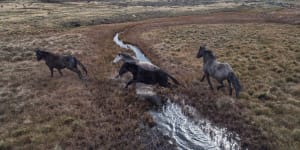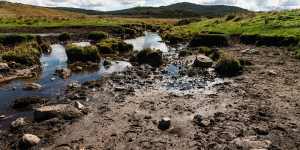The warning was sounded in a submission to a Senate inquiry established in response to despite the state government setting reduction targets.

Feral horses damaging the waterways along the Eucumbene River,north of Kiandra.Nick Moir
According to the Threatened Species Scientific Committee’s submission,feral horses are documented as a threat to 12 of the 14 species of vertebrate animals that occur in the Australian Alps that have been assessed under the Environment Protection and Biodiversity Conservation Act as being threatened with extinction. These include three frogs,four fish,four reptiles and one mammal,the broad-toothed rat.
In each case the impact of feral horses is one of several processes that put species at risk. However,they may be the crucial factor that causes final extinction.
At the current rate of removal of around 1050 feral horses a year,the population in Kosciuszko National Park could leap from almost 19,000 in February last year to around 32,900 by 2027,according to a submission by the Invasive Species Council,based on modelling conducted by ecologist Dr Don Fletcher.

To reach the target population of 3000 by 2027,5991 horses will have to be removed annually.
Delaying action will increase the cost,damage and number of horses killed,said the submission. For example,a three-year delay in reaching 3000 will mean an extra 6000 to 7000 feral horses have to be removed,it says.
The federal environment department’s submission says the rate of horse removal is not on track to meet the target of 3000 horses in the park by 30 June 2027,estimating that approximately 4000 horses would need to be removed annually to achieve this target.
“The department recognises there is an urgent need to improve implementation of existing legislation,guidance and management plans,at the national,state and territory levels to significantly reduce the impact of feral horses in the Australian Alps,including reducing the overall population.”
Management of the park remains the responsibility of the state government,but in its submission the Threatened Species Scientific Committee called on Ms Plibersek to step in and coordinate with states.
“Given the urgency of the problem and the lack under the current EPBC Act of a formal planning process able to respond in a timely manner,the Committee suggests that the Australian Government Minister for the Environment and Water should lead a cross-jurisdictional approach with the relevant state and territory environment ministers to develop coordinated management of horses across the Alps,with the aim of preventing further impacts on threatened species and ecological communities.”
Ms Plibersek said though she liked horses they did not belong in the park,and that she supported humane culling. However,she said management of pests in national parks remained a state responsibility.
“The day-to-day responsibility for protection of National Heritage places,and the management of invasive species rests with state and territory governments,but I am providing financial support to the states and territories to reduce the populations of feral horses in the Alps,” she said.

Feral horse populations have damaged large parts of Kosciuszko National Park,including river banks.James Brickwood
NSW Environment Minister Penny Sharpe said she had sought advice over the “adequacy of the resources,operational procedures and support” needed to ensure the NSW government’s plan to reduce horse numbers to 3000 could be delivered.
The Invasive Species Council’s Jack Gough called on the federal government to take action.
“The lack of action on tackling this major threat seriously jeopardises the,” he said.
“It is now incumbent upon Minister Plibersek to take action to save our native alpine wildlife and stop their habitat being trashed and trampled by feral horses.”
He said aerial culling of horses,which has proved politically unpalatable in the past,should be adopted as the most efficient and human way to remove the pests.
“The public mood has shifted on this issue in recent years,Australians have become better-informed about the damage feral horses are doing.”
Get to the heart of what’s happening with climate change and the environment. Our fortnightly Environment newsletter brings you the news,the issues and the solutions. Sign up.